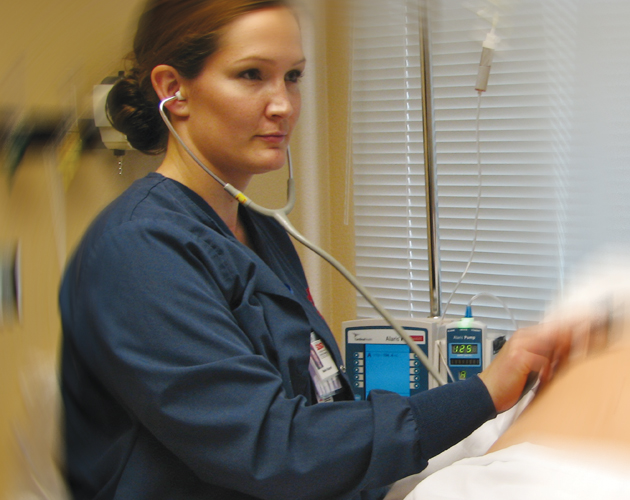Hands-on Learning
Sharp Healthcare supports innovative nursing education

A man in chronic heart failure. A child with a ruptured appendix. A newborn in respiratory distress. Each one needs swift and effective medical intervention.
Until recently, nursing students rarely had opportunities to make mistakes and learn from them, since hands-on learning could compromise patient care. The clinical rotations required of prospective nurses involved more observation than procedural practice and patient interaction. Now, the advent of Human Patient Simulators (HPS), a state-of-the-art technology, has dramatically improved nursing education.
HPS devices are computer-driven mannequins that manifest human physical responses such as respiration, pulse, bowel sounds and pupil dilation. Run by instructors, they can mimic 90 medical scenarios that provide nursing students with hands-on experience in patient care. The result – better trained nurses who can capably respond to a wide range of medical situations on day one in the field.
Sharp HealthCare, a long-time partner of San Diego State University’s School of Nursing, strongly endorses HPS as an educational tool, a view shared by Dean Marilyn Newhoff, Ph.D., of the College of Health and Human Services. This meeting of the minds led to Sharp’s $1 million commitment to establish the Sharp HealthCare Human Patient Simulation Center at SDSU.
For Dan Gross, Ph.D., a San Diego State alumnus and executive vice president of hospital operations at Sharp HealthCare, the decision to support the center was clear. “Sharp chose to support SDSU’s School of Nursing because it’s the county’s largest provider of baccalaureate nurses. SDSU attracts superb educators among the leaders in healthcare and nursing; the curriculum addresses what’s happening in our hospitals,” said Gross.
“SDSU also has an excellent reputation for producing knowledgeable nurses who successfully transition into San Diego’s work force. That’s critical to alleviating our local nursing shortage,” he said.
Although simulators are costly to equip and staff, the center at SDSU is seen as a vital investment. “The Sharp HealthCare Human Patient Simulation Center will provide an efficient way to expand clinical nursing education beyond the space available in hospitals for clinical rotations,” Gross said.
With seven simulators — an infant, a child and five adults, one of which simulates childbirth – SDSU’s center is the largest in Southern California. It houses more than half a million dollars in equipment. Center Director, Mary Beth Parr, R.N., M.S.N., says the facility was built to replicate the hospital environment, complete with beds, IVs, incubators, medical charts, equipment to monitor vitals and telephones to make simulated calls to doctors and lab technicians. By providing a safe environment to enhance knowledge and build self-confidence, the center helps students prepare to handle the situations encountered in the field, Parr said.
Prior to a simulation, students complete pre-lab work related to a medical condition. When they arrive at the center, they get into character – such as a charge nurse or family member. The instructor runs the lesson (controlling the “status” of the mannequin as it exhibits changing physical reactions and verbal responses). Simultaneously, the students confirm the patient’s history and information, execute stated orders, deliver medications and prepare to implement treatment quickly and correctly.
After using HPS for four semesters, senior Natalie Claypool can speak to the value of the technology. “The simulation work I’ve done has kept me on my toes,” she said. “I’ve learned to better manage my time and prioritize patient care. There have been instances where I didn’t understand concepts in lectures, but HPS labs reinforced the material. After the simulation, I remember my mistakes and I feel prepared to respond more quickly during my clinical rotation at the hospital.”
Newhoff and Parr agree that the Sharp HealthCare Human Patient Simulation Center will put SDSU on the cutting edge of nursing education by providing all of the advantages offered by current teaching technology. From Parr’s perspective, simulation takes nursing education to the next level.
“By videotaping our exercises, we can discuss how to do things differently,” Parr said. “As an educational tool, simulation is invaluable; especially for hands-on learners. For me, the greatest reward is the moment during the exercise when I see the light go on in a student’s head. That moment of realization, when the student understands, ‘this is really happening and I have to act,’ is priceless.”



